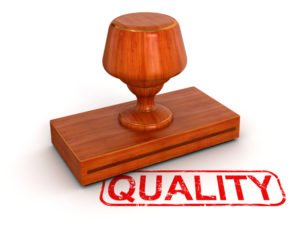Aromatherapists are mainly interested in the healing properties of essential oils. The flavor and fragrance industries, by far the largest buyers of essential oils, are most interested in the flavor or the fragrance.
So, what makes a pure essential oil or a high-quality essential oil for aromatherapy use? When aromatherapists look for quality essential oils, they look for essentially six basic characteristics.
High-Quality Essential Oil Characteristics
 An essential oil should be derived from only one specific plant species, e.g., true lavender essential oil should be made of just Lavandula angustifolia, and sweet orange essential oil should be made of just Citrus sinensis. Lavendin (Lavandula x intermedia) is commonly used by the fragrance and flavor industry in their commercial products, in part, because the plant yields more essential oil and thus reduces the cost. It has a softer scent but does not have the healing properties of the more medicinal L. angustifolia. Bitter orange (Citrus aurantium) does yield wonderful essential oils, but they have very different properties than sweet orange.
An essential oil should be derived from only one specific plant species, e.g., true lavender essential oil should be made of just Lavandula angustifolia, and sweet orange essential oil should be made of just Citrus sinensis. Lavendin (Lavandula x intermedia) is commonly used by the fragrance and flavor industry in their commercial products, in part, because the plant yields more essential oil and thus reduces the cost. It has a softer scent but does not have the healing properties of the more medicinal L. angustifolia. Bitter orange (Citrus aurantium) does yield wonderful essential oils, but they have very different properties than sweet orange.- An essential oil should be derived from specific parts of a plant. Which part of the plant is used depends on the plant species, e.g. sweet orange essential oil is derived from the rind, frankincense is derived from the resin, jasmine is derived from the fresh flowers, and peppermint is derived from the whole plant from the ground up (not the roots). The chemistry and healing properties of a plant can vary from one part of the plant to another. Bitter orange (Citrus aurantium) yields neroli (from the flowers) and petitgrain (from the small immature fruits and sometimes the leaves). Both are excellent essential oils but the healing (therapeutic and energetic) properties are very different.
- An essential oil should be whole or complete, meaning that all of the expected chemical components are present in the expected percentage ranges. Note that the flavor and fragrance industry sometimes removes certain chemical components, e.g., terpenes, from essential oils because of their undesirable characteristics given the industry’s needs or objectives. The removal of some chemical constituents also increases the concentrations of the remaining chemical constituents. These essential oils should not be used for aromatherapy.
- An essential oil should be natural meaning that no additional chemicals are added: neither new chemicals nor more of the existing chemicals. The flavor and fragrance industry will sometimes add more of a particular chemical constituent in order to maintain a particular and consistent chemical composition from one batch to another. Again, these essential oils are not pure essential oils and should not be used for aromatherapy.
- An essential oil should be pure meaning that there are no contaminants, impurities, synthetics, additional substances or chemicals present. Additives are sometimes present in fragrance and flavor industry oils, but should never be present in essential oil used for aromatherapy. If additives are present, it’s not a pure essential oil.
- An essential oil should be genuine meaning that it is what the seller claims it is. It is accurately and truthfully labeled and indicates the species, origin, and date of distillation. If these specifics are not printed on the label, the seller should be able to provide the information.
Knowing the Quality of an Essential Oil
There is no independent essential oil certification body or process. Don’t be fooled by certification claims. There are, however, a number of tests that can be performed to gauge essential oil quality. Perhaps the most common is Gas Choreography Mass Spectrometry (GC/MS). Suppliers will send samples to an independent lab or conduct these tests themselves. While the tests are very helpful, the results will vary somewhat depending on the lab and its ability to identify a wide range of chemical constituents. The GC/MS and other tests are costly and prohibitively expensive for some very good suppliers. The best practice is to know your suppliers, the source of their supply, how they gauge the quality of their sources, and how effective their essential oils are in use.
For more on purchasing quality essential oils, see my blog post How To Buy Essential Oils
